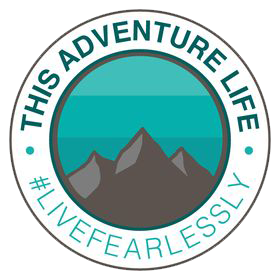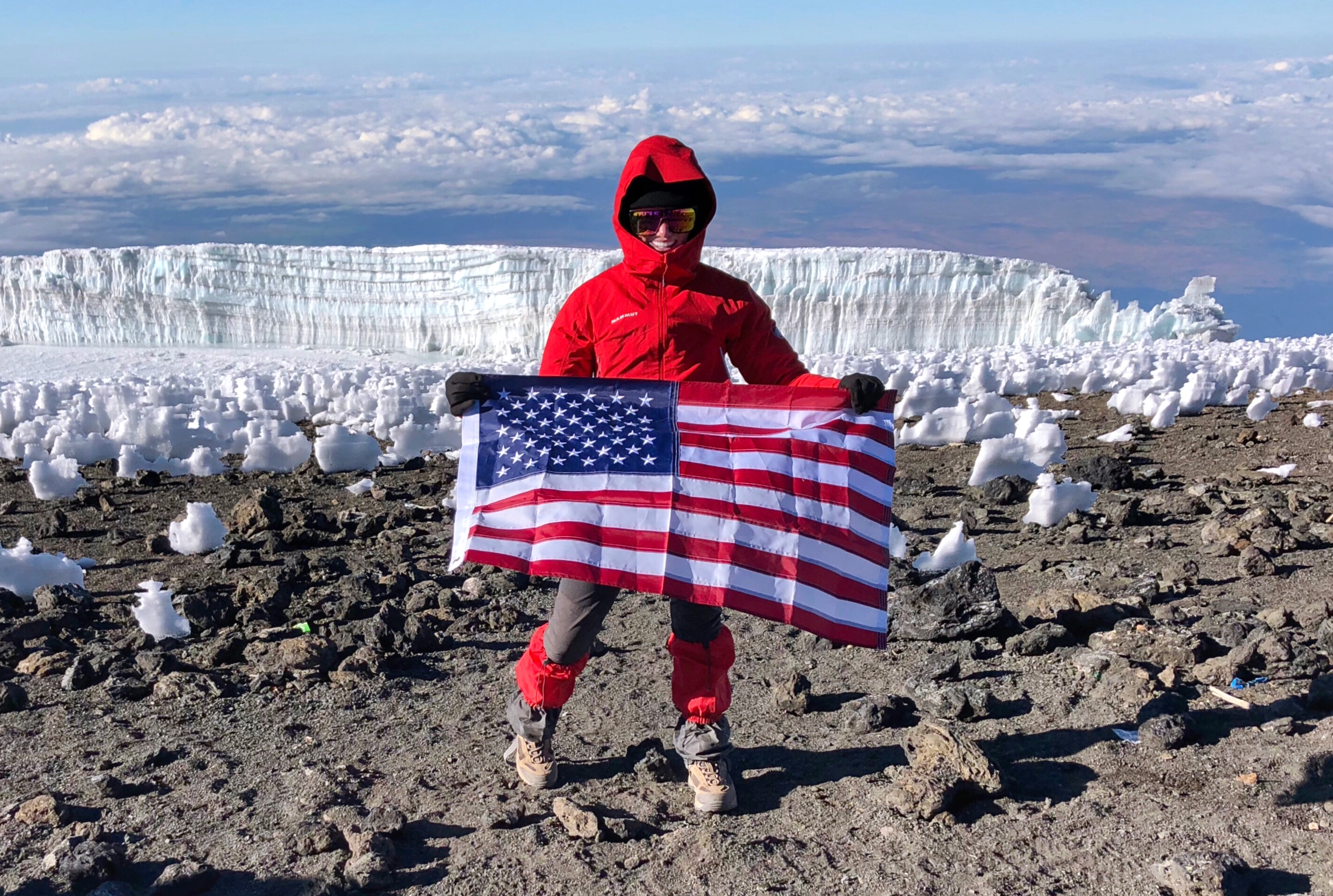When I was a kid I had always been intrigued by adventures and expeditions. I loved nothing more than looking at National Geographic magazines, watching documentaries, playing with action figures of explorers and looking through my grandfather’s photos from his travels, framed all over his walls. One story that always stuck out in my mind was his journey to Kilimanjaro, and how he almost made the summit.
When I asked my grandfather, a former Marine, real estate entrepreneur and world traveler, how attainable Kilimanjaro was, he told me his story. He had hired a private guide when he was on a safari trip in Tanzania, and thought it would be an incredible challenge to hike Kilimanjaro. He had no prior training; he just decided to attempt it spontaneously. After a few days on the mountain, he made it to just below the summit (I could not remember if it was Stella or Gilman’s Point) before extreme symptoms of altitude sickness kicked in, and he was forced to quickly descend. I was so fascinated by his story that I promised him I would make the summit one day, and when he passed away a few years later I knew I had to follow through.
Reaching the summit of Kilimanjaro had been a goal of mine for years, but always seemed so unattainable. It was so far away, and seemed like a daunting task to travel to. I had also never hiked higher than 15,000 feet before, and standing at over 19,000 feet, Kilimanjaro was an intimidating beast of a mountain.
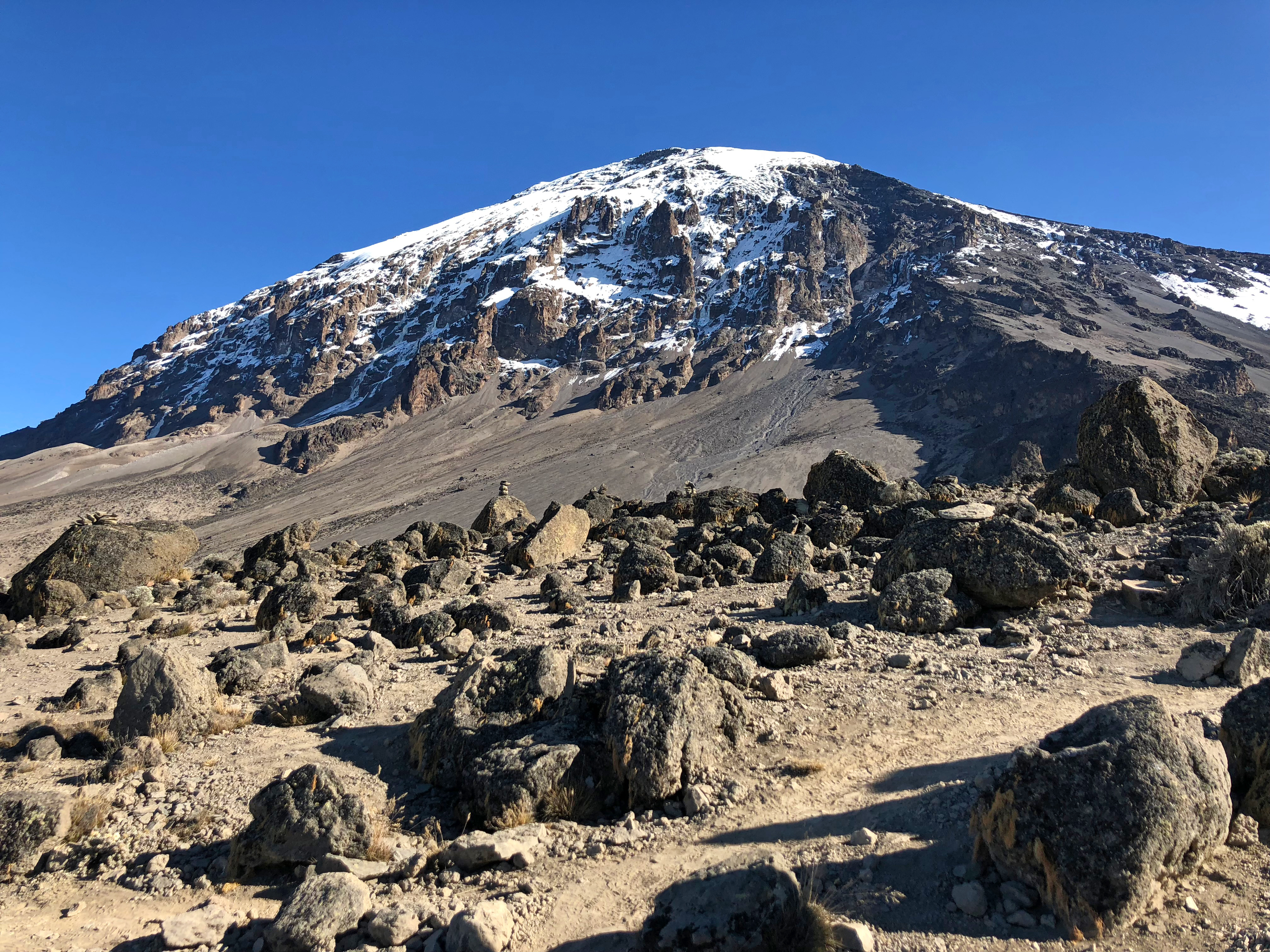
About two years ago I decided that 2018 would be the year I would climb Kilimanjaro. One reason was that it marked the 20th anniversary of my diagnosis with scoliosis, and the 19th anniversary of my spinal fusion surgery. Everything I had endured, from bullying to body dysmorphia, had given me the strength to become who I am today. I knew I had to complete the summit to celebrate my growth and journey into finding self-love, confidence and the bravery to pursue my dream life.
The other reason? It just seemed right, and I was tired of putting it off.
I signed up for the full moon hike with Trekking Hero (departing September 20), and a two day wildlife safari in the Serengeti afterwards. I chose the Lemosho Route because it offers better time for acclimatization, sees lower crowds and is known for beautiful scenery and chances to see wildlife. Compared to some of the more popular routes, the Lemosho Route has a higher chance of summit success rate.
I arrived a few days early to Moshi to get some rest so I wouldn’t be jet lagged during the trek. I had waited and trained so long that I thought it would be such a waste to be tired on the trek. The days I was there I just tried to relax, do some yoga and get mentally prepared for the trek ahead. I would tell myself that I was right where I needed to be and that everything would be not just alright, but amazing.
On the 19th I met the rest of my group. It was an interesting mix of people from all over the world, brought together by the desire to summit the mountain. I was the youngest one by a few years. We had eleven climbers in total, ages 31 (me) to almost 70. Everyone came from different backgrounds; we had a scientist, a videographer, a few retirees, an electrical engineer, a data engineer, a nurse and myself, a content creator and adventure blogger.
We all came here for different reasons. Some of us to tick if off the “bucket list,” some of us, like myself, for personal … and some just to get a good high altitude hike in.
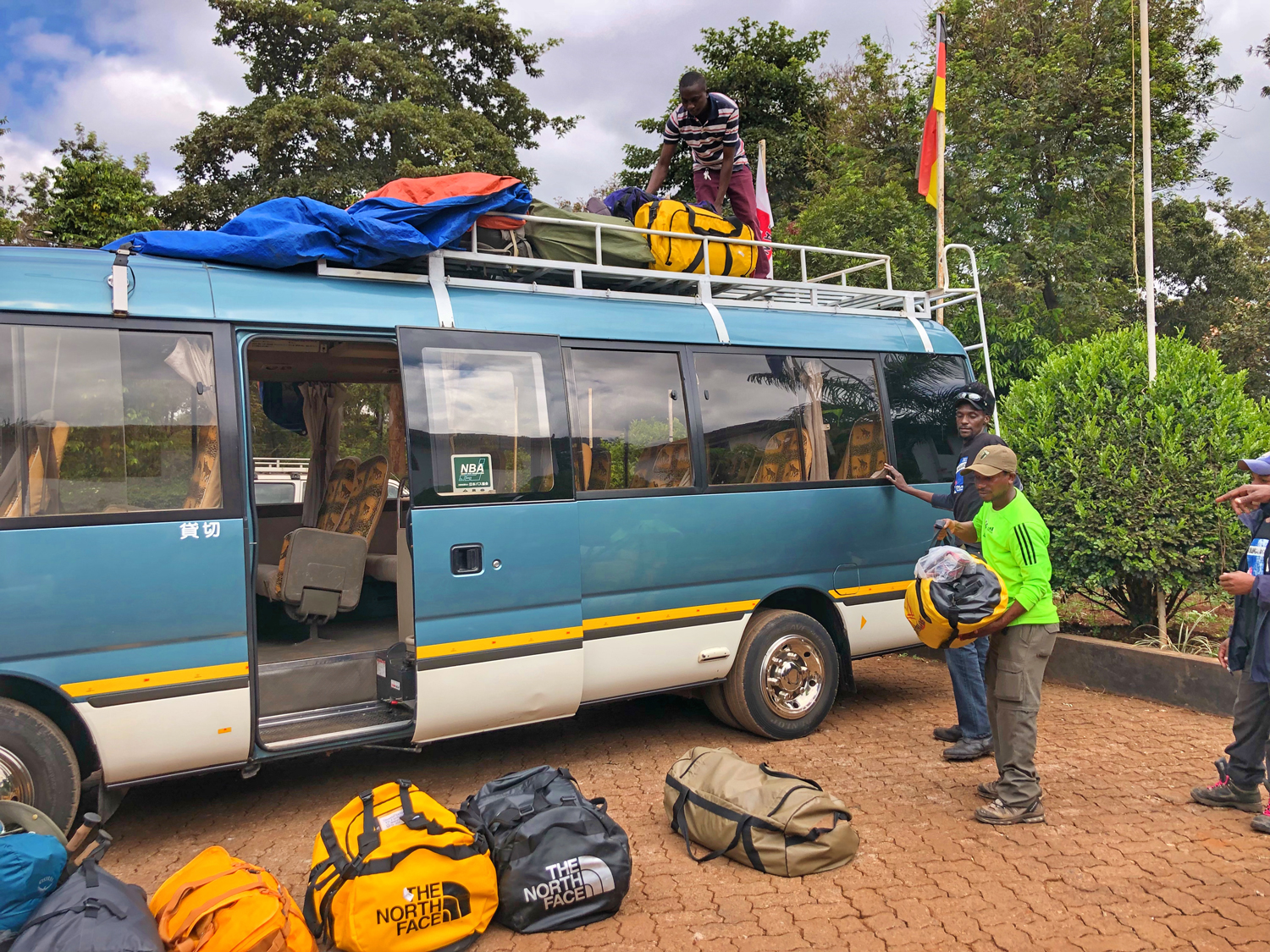
Day One: “Pole Pole”
On September 20th we departed the Keys Hotel in Moshi for Kilimanjaro National Park. Our official starting point for our route was the Lemosho Gate but first we had to check in at the Londorossi Gate, which was located a bit further up the road. You have to check in here and again at every camp you spend the night. Each camp also has giant signs, which are perfect for that social media shot to prove you made it! From the hotel, it took about three hours to the gate. The drive is interesting, and takes you through the remote countryside. Keep a lookout for Mount Kilimanjaro in the distance (usually hidden by clouds in the afternoon), wildlife and of course, road construction.
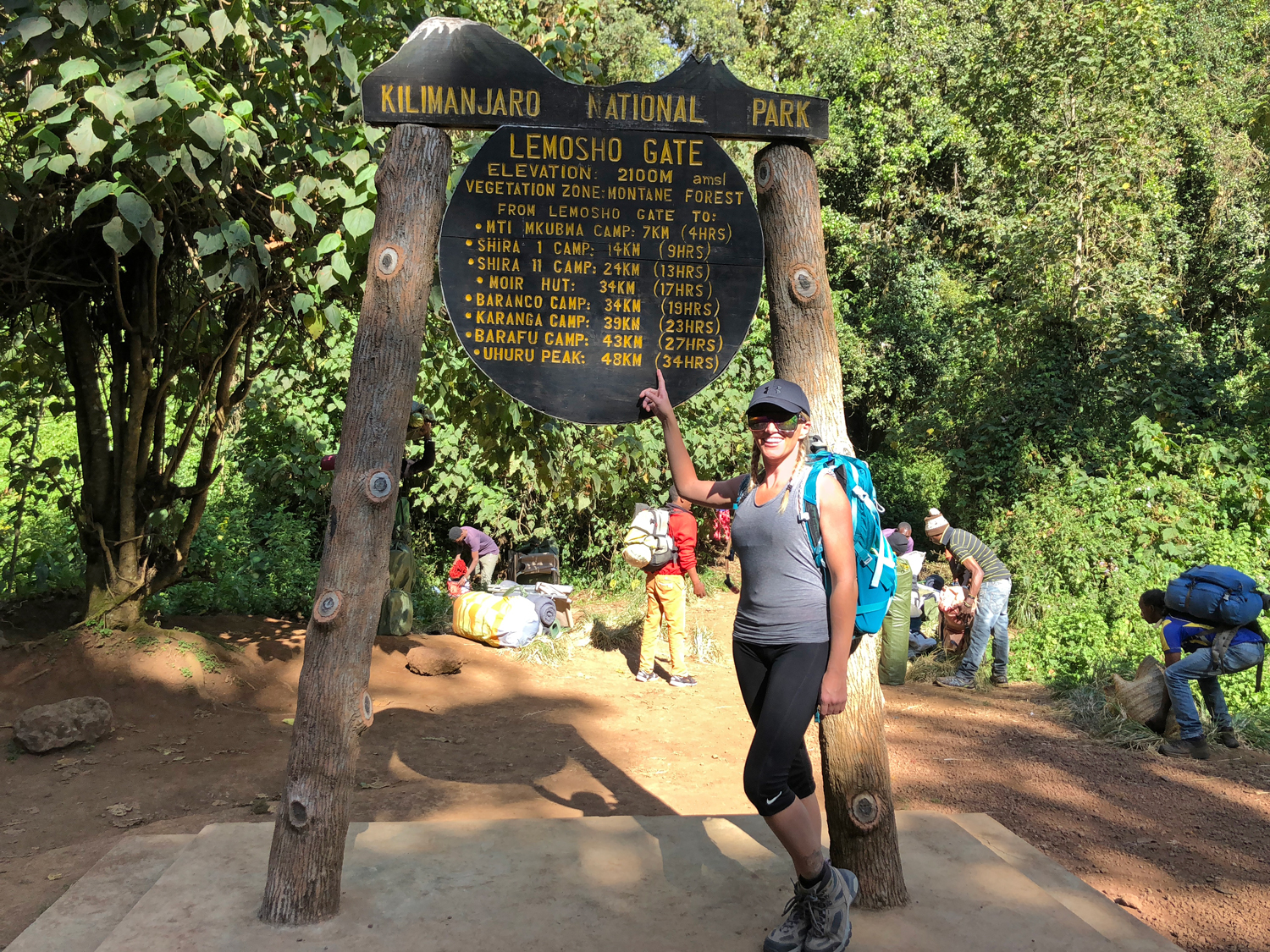
I never knew how slow “pole pole” actually was until the moment we began our trek, and we kept that pace during the entire ascent. Luckily the way down was a lot faster (scree-skiing down from Uhuru Peak is an experience in itself). As painful as the pace was sometimes, it really helped with acclimating to the altitude and kept me present in the moment.
The trail here begins in the lowland forests, and is full of life. The whole experience here is just otherworldly, and is something you don’t typically see when you research the Kilimanjaro trek. It’s so lush, so green. Sounds of birds chirping and monkeys completely surround you. There are various monkey species hanging out in the trees above, while colorful birds fly around. You will most likely see lots of Colobus monkeys jumping from tree to tree, right above your head. It’s quite the experience, and I must have filmed them for at least twenty minutes. I tend to take way too many photos of the wildlife, but they’re so damn cute!

It was pretty hot and muggy in this area, but I packed layers just in case. The weather can change on the mountain, and at an incredibly fast pace. Always carry a poncho, a backpack cover and a few extra layers in your day pack. You will not get to your duffel bag until camp.
We walked for about four miles until we ended up at Mti Mkubwa Camp, situated at just 8,694 feet (2650 meters). Located in the montane forest vegetation zone, it was still very warm here. Enjoy it, as the other nights get pretty cold. We were given hot water to wash off, had a delicious hot meal and set out to sleep. We would get up at 6 am and begin to gain more altitude the next day.
“Easy peasy,” as they say. That night I was lulled to sleep by the sounds of birds and insects above.
Day Two: “Hakuna Matata”
Hakuna Matata. It means no worries, and that pretty much sums up this relatively easy day.
We left Mti Mkubwa Camp, and the montane forest vegetation zone, around 7 am after a hearty and delicious breakfast. Our itinerary for today was to bypass Shira 1 camp (our lunch spot) and go straight to Shira 2 Camp. It was a pretty steady uphill hike but I love a good ass-kicking to start my day. The weather up top changed drastically, and fast. The fog quickly rolled in and it was time to seriously layer up. Be prepared for quick changes in weather; it can go from hot to cold, and back to hot again in hours.
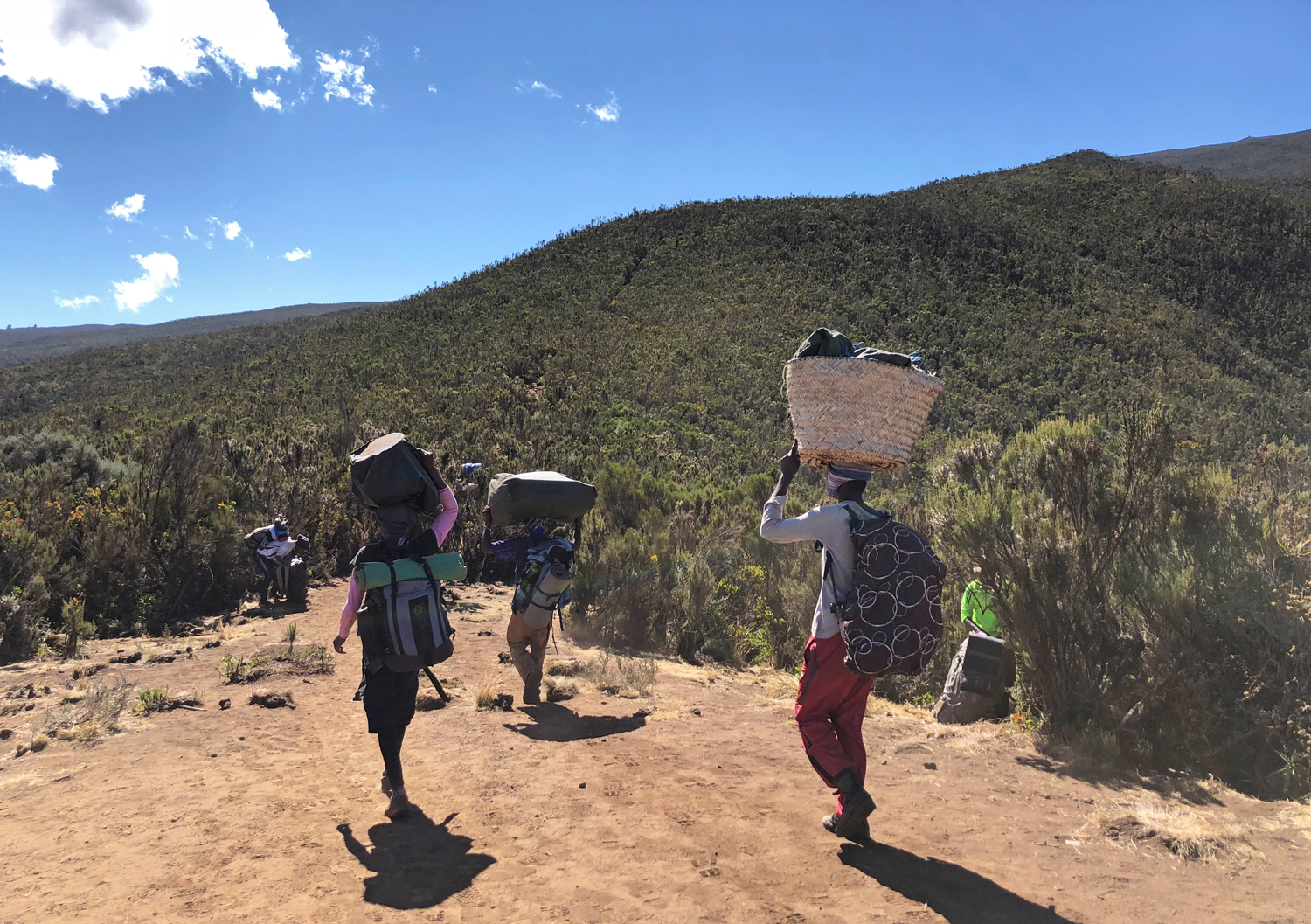
We made our descent into the valley and had our lunch break at Shira 1. The box lunches are actually really good, and contain lots of nutritious food, such as chicken, sandwiches, juice, fruits, vegetables and light snacks. One of our members go hit pretty hard with altitude sickness, and it was really apparent during our lunch break that he was going to need some help. Fortunately, he identified with having altitude sickness, had lots of water and told the guides, who helped guide him slowly to camp. If you feel symptoms of altitude sickness, make sure to always tell your guides.
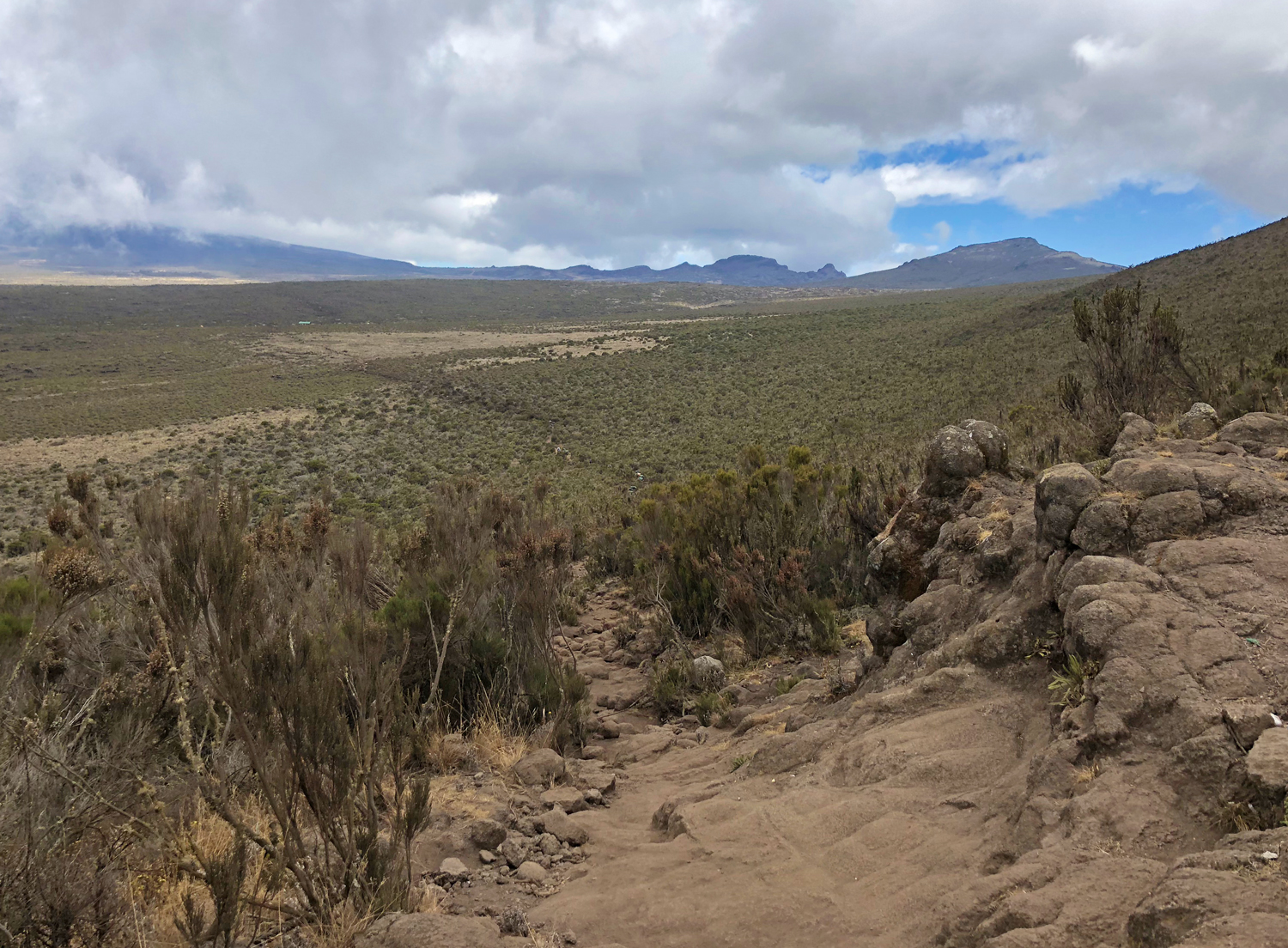
We pushed on for a few miles, and ended our hiking for the day at Shira 2. It was here that I got to see the peak of Kilimanjaro for the first time, although it was during sunset so it was pretty dark. The sunset was absolutely gorgeous, and looking at it from above the clouds was a really memorable experience. We were lucky to have such stunning sunsets the entire trek.
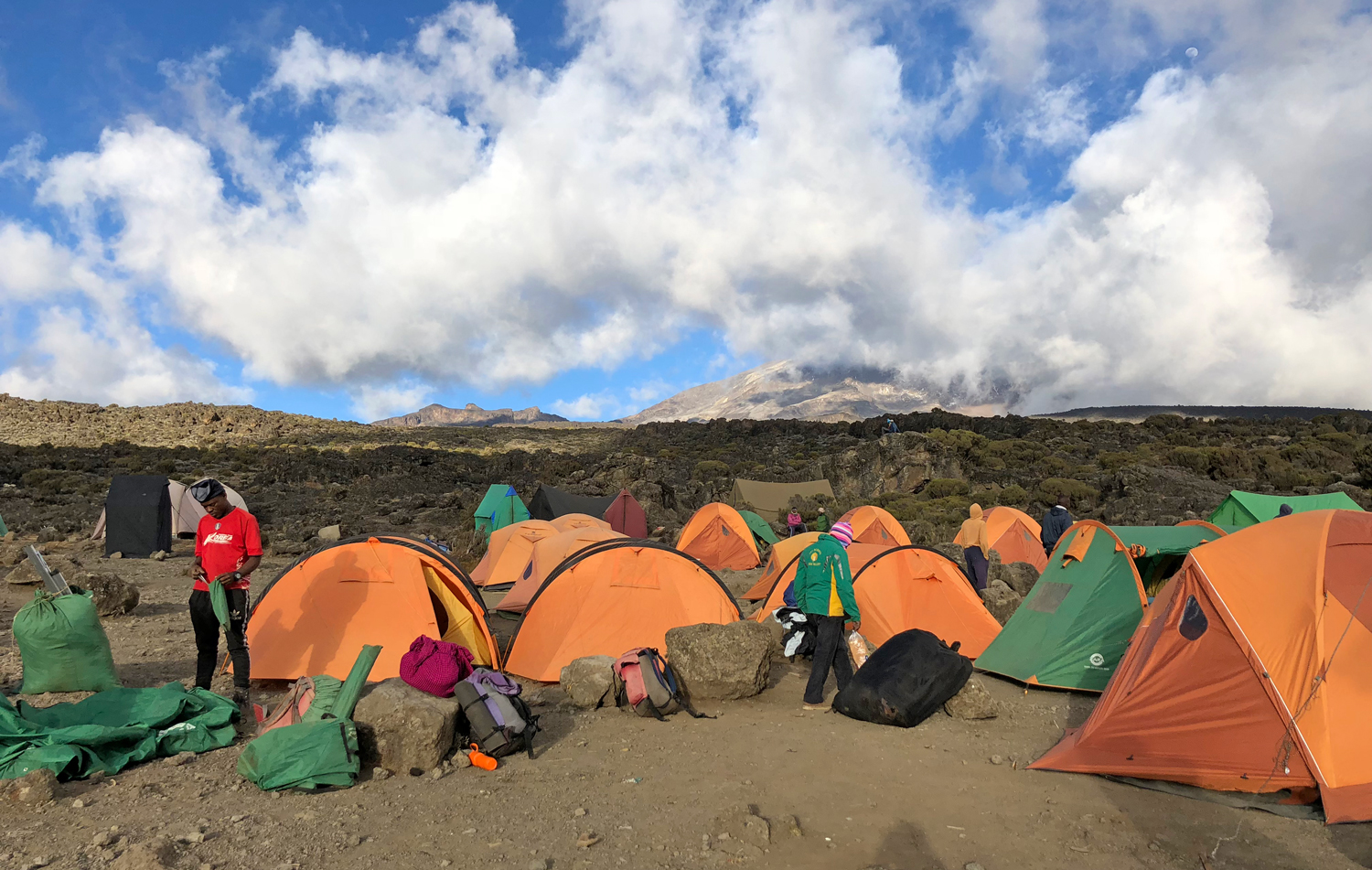
Day Three: Acclimatization Day
Honestly I teared up a bit when I first got a glimpse of Kibo Peak during daylight; it was so much more grandiose and intimidating than I thought it would be. It was almost like I had some sort of a spiritual moment that morning.
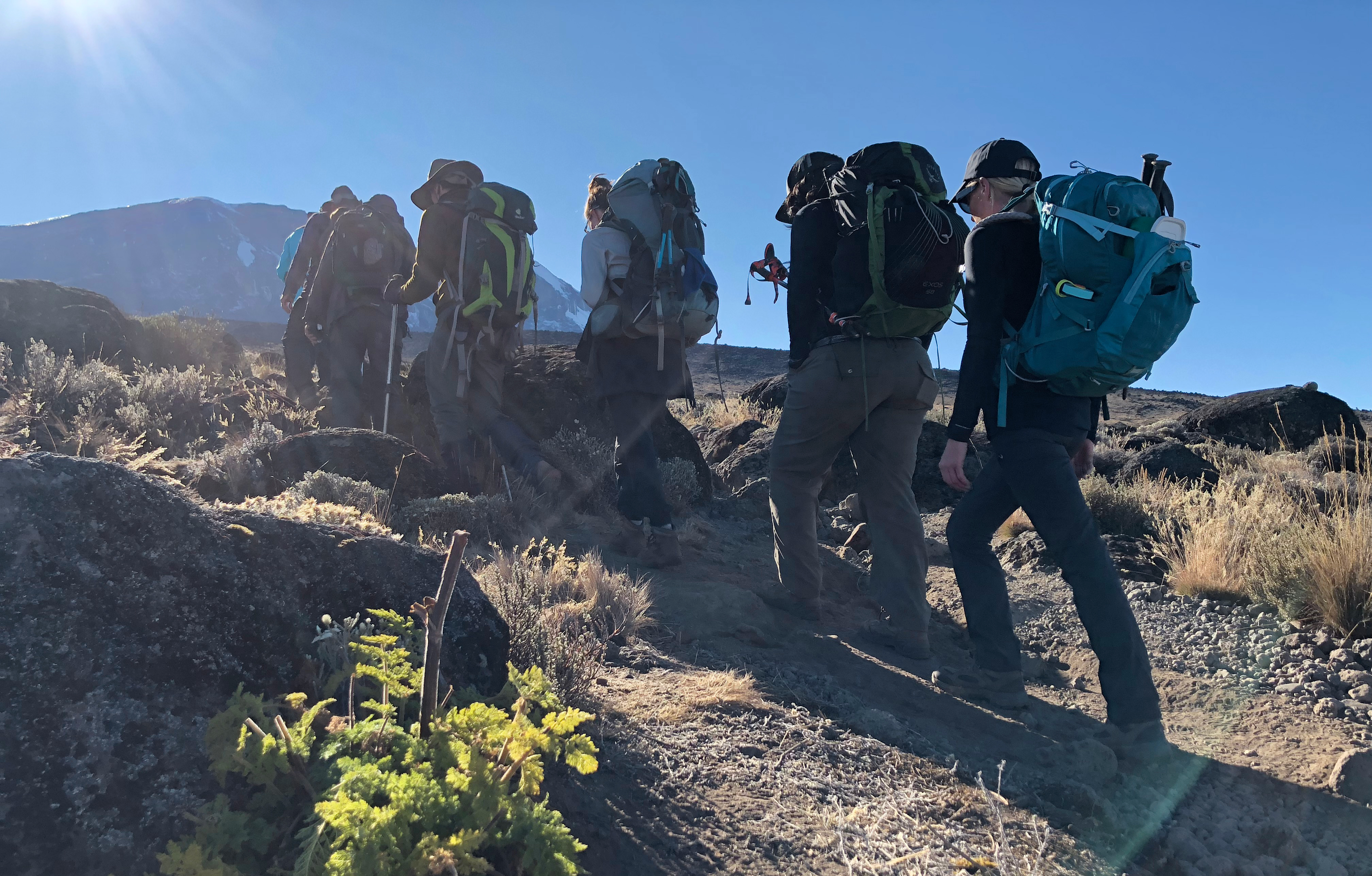
It was yet again another perfect sunny morning, and as usual we all woke up at 6 am, had breakfast and set on our way. Today was our “acclimatization day,” where we would spend the day ascending the rugged terrain to Lava Camp. Located at just over 15,000 feet, it would be the highest altitude I have ever been to thus far. I realized that if I felt fine here, the chances of me completing the summit looked even better. My luck had been great so far, but I knew things could change quickly on this mountain.
We spent quite a bit of time at Lava Camp to get ourselves used to the altitude. I felt great at the altitude, but got cold when the clouds quickly rolled in and the wind picked up. We ate our always delicious boxed lunch at the rocks to try to shield ourselves from the wind. As cold and a bit bored as I was, I am glad we spent the time here to help with the acclimatization process. After acclimatizing at over 15,000 feet, I realized that every step up from there was my new personal record. That felt pretty good, and kept me motivated to push forward.
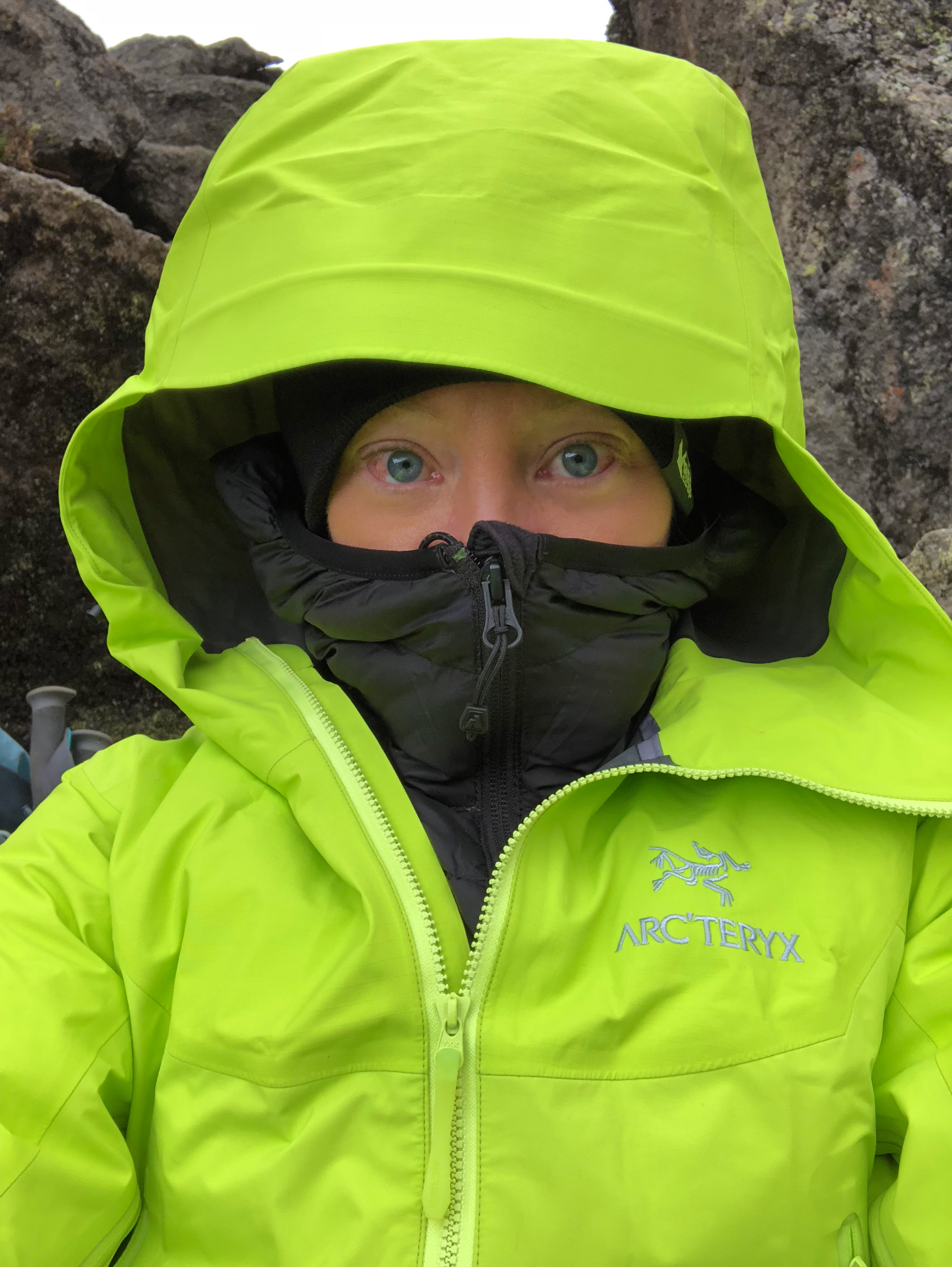
After about an hour at Lava Camp, we made our way down towards Barranco Camp, and got to see the awesome Dr. Seuss trees (they are actually called Senecios) along the way. Of course, I had to take a lot of photos. They reminded me a bit of the Joshua Trees I used to photograph lots back in college; gotta love some nostalgia.
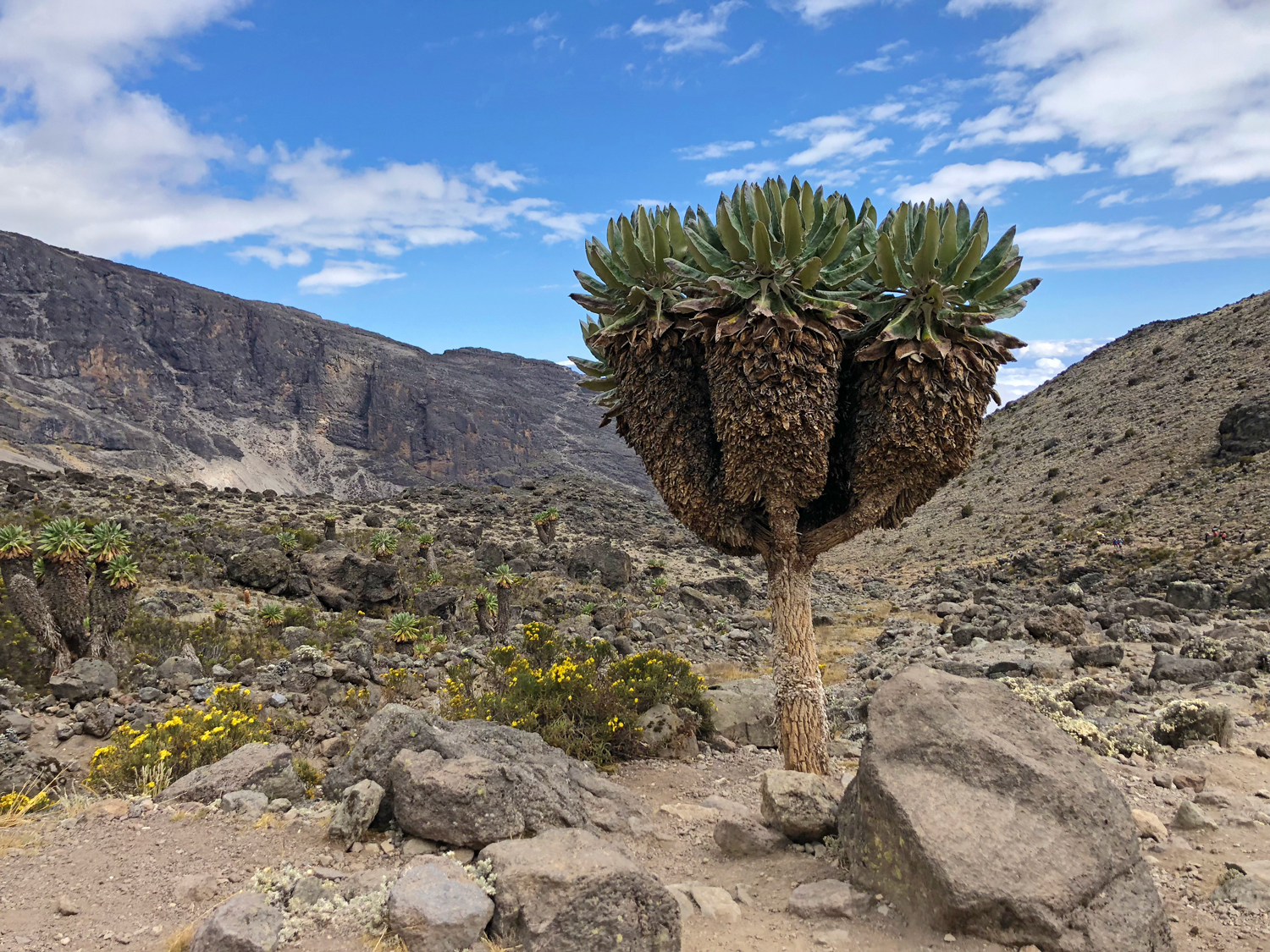
I got a glimpse of the Barranco Wall on the way down to camp and thought “bring it!” I had heard a lot of stories about the wall, and was ready for another challenge. Honestly, it’s a lot easier than you think, but I’ll save that story for Day Four.
That night I saw the most amazing sunset, the best one on the trek hands down, as the last bit of sunshine illuminated the peak of Kilimanjaro. It only lasted a few minutes, and I felt so lucky to witness the event and get the shot.
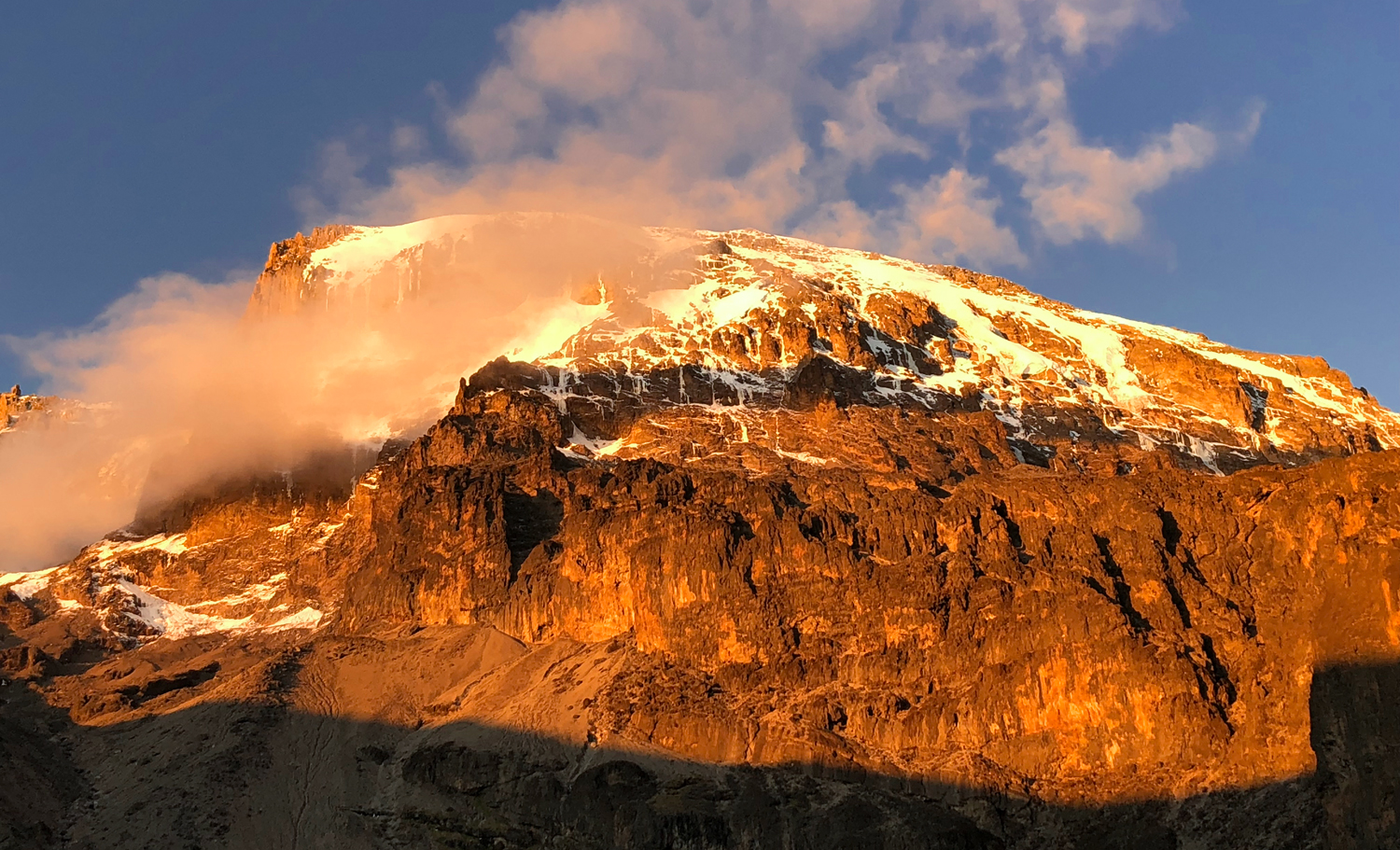
Looking into the night sky and all of the shining stars I knew I was ready. In my heart, I knew I would make the summit this trip. I felt so much positive energy surround me, and I made sure to put it right back into the universe.
Day Four: Conquering the Barranco Wall
For most people hiking the Lemosho or Machame routes, the mere thought of the Barranco Wall terrifies them. It’s called the “Breakfast Wall” because it’s conquered right after breakfast (it’s just a few minutes from camp). Honestly, I thought this part of the hike was pretty damn fun. It’s a relatively easy “scramble,” meaning that you don’t need any technical skill but will need to use your hands to help pull you up in some parts. Make sure to keep your trekking poles stored on your day pack during this part, as they would just get in the way. I definitely recommend getting some scrambling experience beforehand, as it will be pretty easy compared to a lot of other scrambles out there. It just appears hard because of the height.
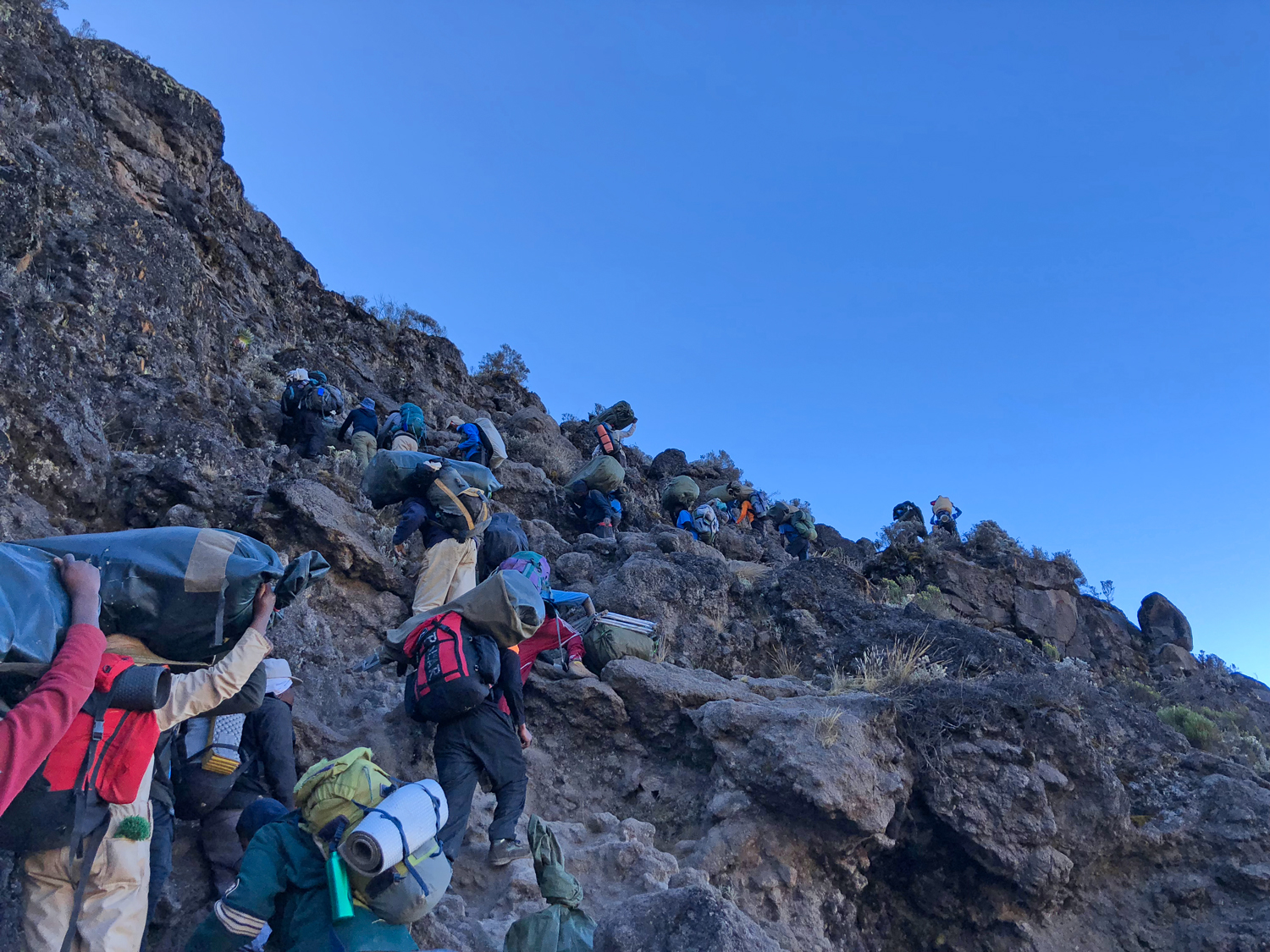
After we completed the wall, we still had miles to go. We hiked for about an hour longer until we ended up at one of the most stunning viewpoints so far. From here, you can see the peak of Mount Meru, and is often viewed rising above a sea of clouds below. We were told that if it is a clear day, the entire city of Moshi is visible. Of course, we had to take lots of photos here, and even ran into some people we had met from other trekking groups.
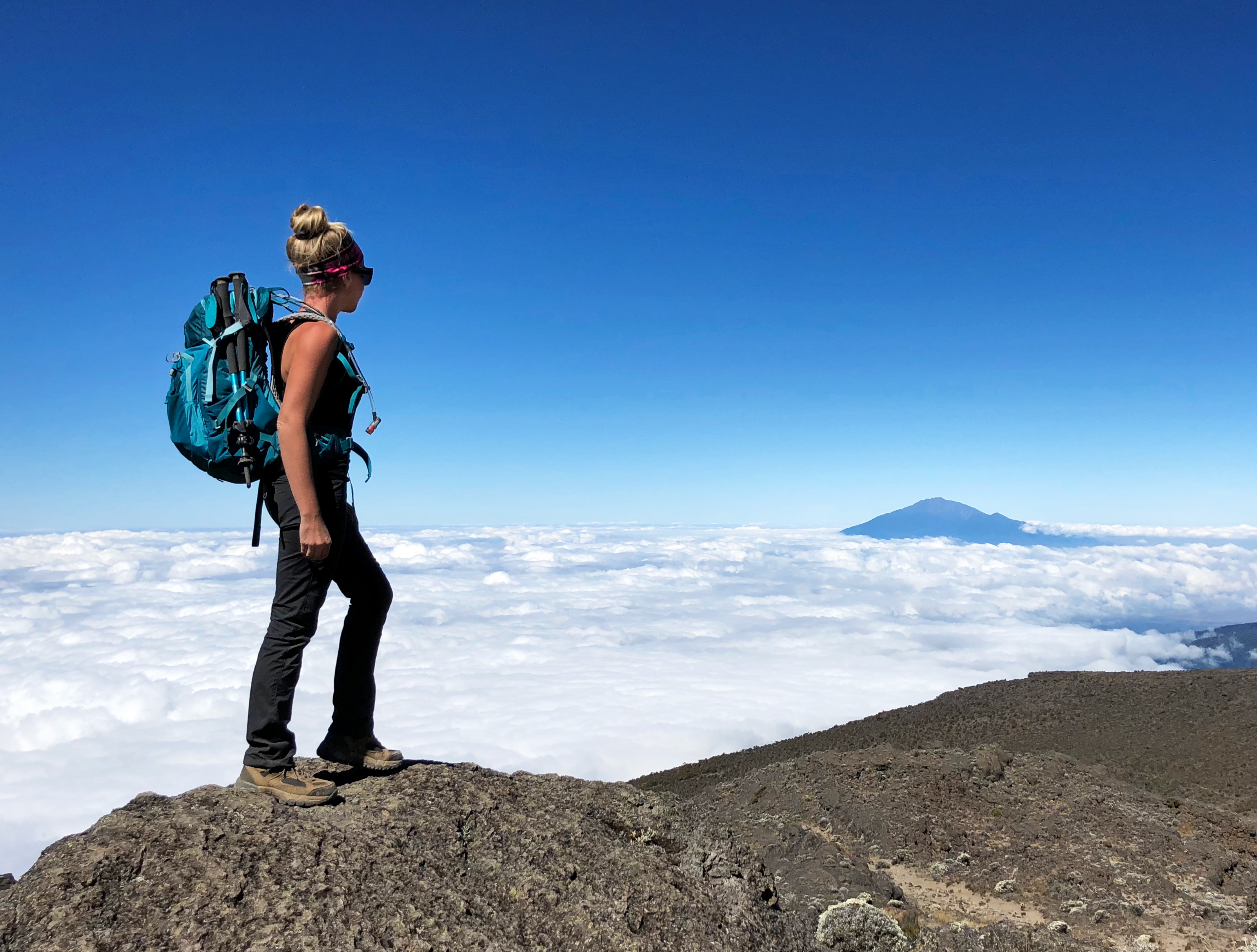
We then made our way to Karanga Camp, and after getting out gear situated in our tents went on a short acclimatization hike. I felt great: no altitude sickness or any signs of food poisoning (the two major reasons people don’t summit). Once at our acclimatization spot I could partially see the route to Uhuru Peak via Barafu High Camp. I felt strong, confident and at peace. Everything I had trained so hard for, mentally and physically, was coming true right before me.
We decided to head back down to camp as the clouds started rolling in and the temperatures dropped. We were getting tired and hungry, and the summit was well within reach. We needed all the rest we could get.

Day Five: “Babu Kubwa”
Today we set off for Barafu High Camp, our last camp before we attempted the summit bid. At about 15,330 feet (4,673 meters), it was our highest camp on the trek. This meant that we still had over 4,000 feet to the summit, and I had head the trek was a steep one! We hit the trail after another delicious and hearty breakfast. Like every other day, I had to shed some layers about an hour in as the sun is pretty strong at altitude.
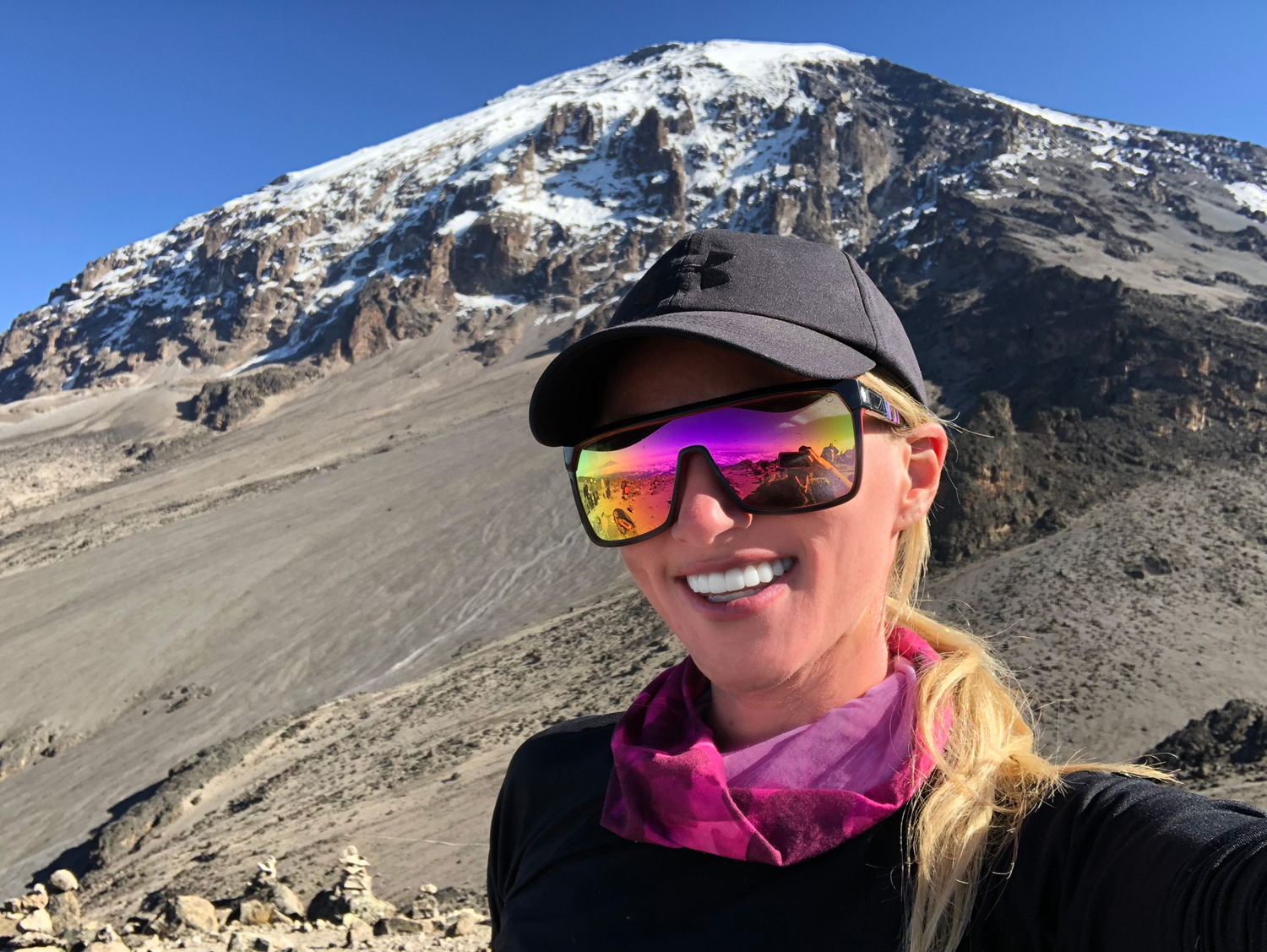
Today was a “short hiking day” complete with another acclimatization hike. The reason for this is to give us plenty of time to sleep before waking up early for the summit bid. We would need all of our energy for the hike awaiting us. The hike to Barafu Camp itself wasn’t that hard, or too long.
Once we got into camp, we went straight into our acclimatization hike, and it was here I witnessed some of the worst cases of altitude sickness I have ever seen. It was honestly a bit disheartening. One guy had to be restrained by a few guides, as was completely disoriented and agitated! His girlfriend was behind him recording the entire process. Poor guy. A few others passed us, looking exhausted and defeated. I decided to push on and not let it get to me. I had to focus on myself and get all the negative energy out of my mind.

We had an early dinner, and there were a few people in our group who didn’t want to eat. In my experience, even if you don’t feel like eating, you really should try. During summit day you need all the nutrients you can get. Skipping a meal might mean skipping the summit. I tried to sleep right after, but my mind was racing with excitement. I must have checked over twenty times to make sure I had everything ready! I got some sleep, but it was hard. And cold.
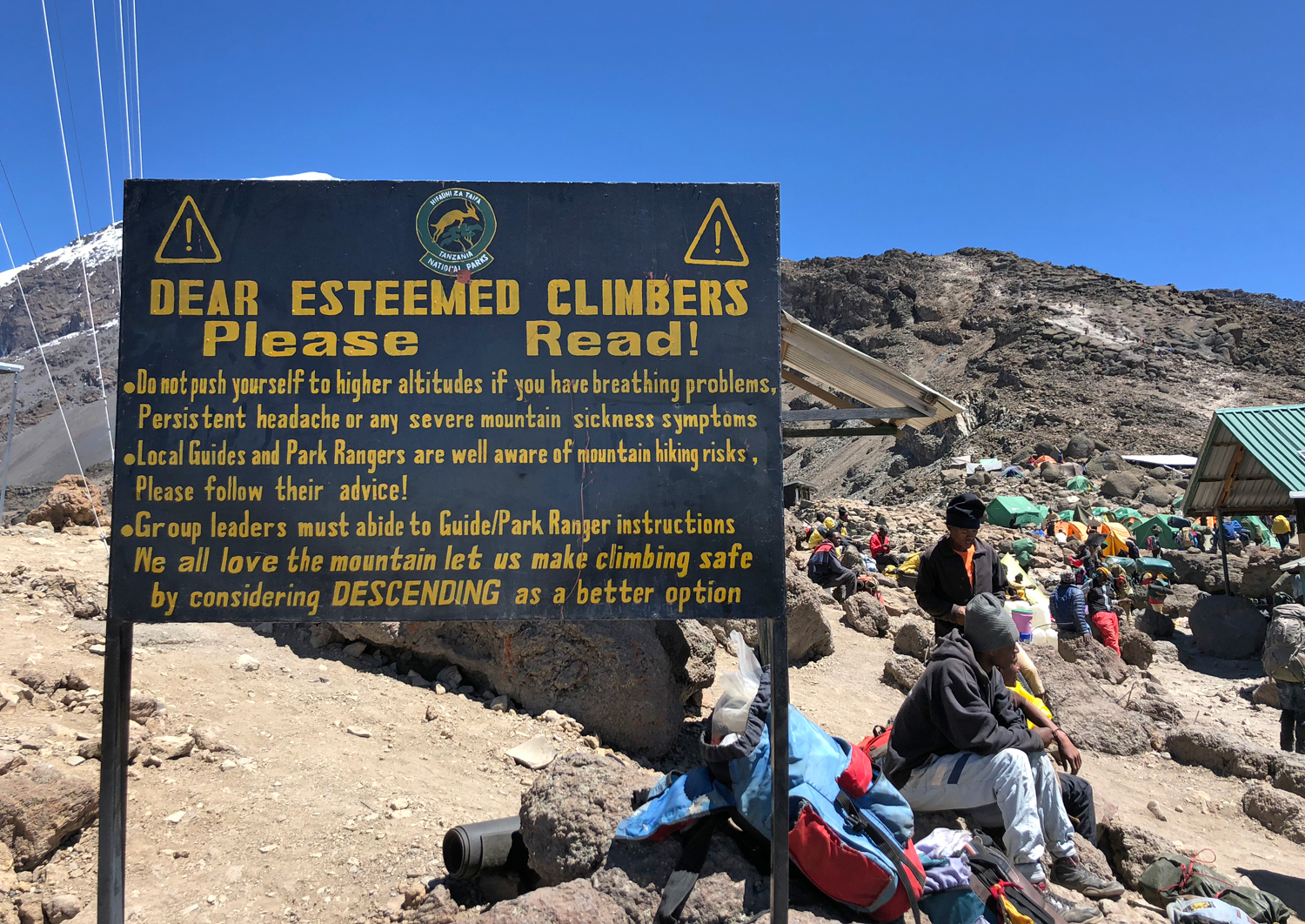
Around eleven pm, we woke up and got ready for the summit bid. I made a point to eat a lot before the hike, because it would be many long hours before we were back at camp for lunch. I even took some biscuits to go (there were a lot left, as the rest of the group didn’t eat much), and put them next to the candy and a handwarmer in my pocket. (TIP: Bring your favorite candies and snacks with you to refuel. Also, keep your water warm! Your water bladder will most likely freeze halfway through, so I suggest bringing a water bottle as well, and covering it with a sock to keep warm. You need to stay hydrated during this trek).
“Babu Kubwa.” It’s all good.
Day Six: The Roof of Africa
Right when the clock hit midnight, just like our guides told us, we started our trek, slowly, to Uhuru Peak. The sky was perfectly clear, and the full moon illuminated the trail and peak above us. A steady line of headlights above and below us marked the trail, making sure we knew where we needed to be and how far we had come. There were numerous people being escorted down as we made our way up, and this time I couldn’t even bring myself to think about their situation. Along the way I witnessed many people sitting with their heads in their laps trying to catch their breath and regain their strength, all wondering if they would make it.
The worst part for me was the cold. Ok, and the wind. I had really layered up the night before, but for some reason, despite wearing 2 layers of gloves, my hands were unbearably freezing for a few hours of the summit push. I kept moving them around and placing hand warmers inside, but it didn’t seem to help. My fingers were hit the worst. I tried to concentrate on other things, such as the sparkling trail of lights, the full moon or eating from my bag of Swedish Fish and it seemed to work alright.

The sun began to rise around six am, and nothing could have made me happier in that moment. I warmed up quickly, and my fingers were no longer cold. The landscape was dramatically different; it was a glowing orange from the sunrise. I could see the glaciers as I continued the ascent, and I knew I was almost at the summit rim.
Once I got to Stella Point (where I believe my grandfather had to descend), I knew I had made it. There was no turning back now. In fact, with the warm sun shining, calmer winds and a short break for water and snacks, I got a second burst of energy and quickly made my way towards the summit. I was in awe of the surrounding glaciers and the crater and had to stop every now and then to take a picture and take it all in. It was much more magical than I had imagined it to be: the bright sun, fresh crisp air, sparkling glaciers and ice dotting the trails all seemed so otherworldly. I felt like I was on another planet. I felt proud, and a bit overwhelmed.
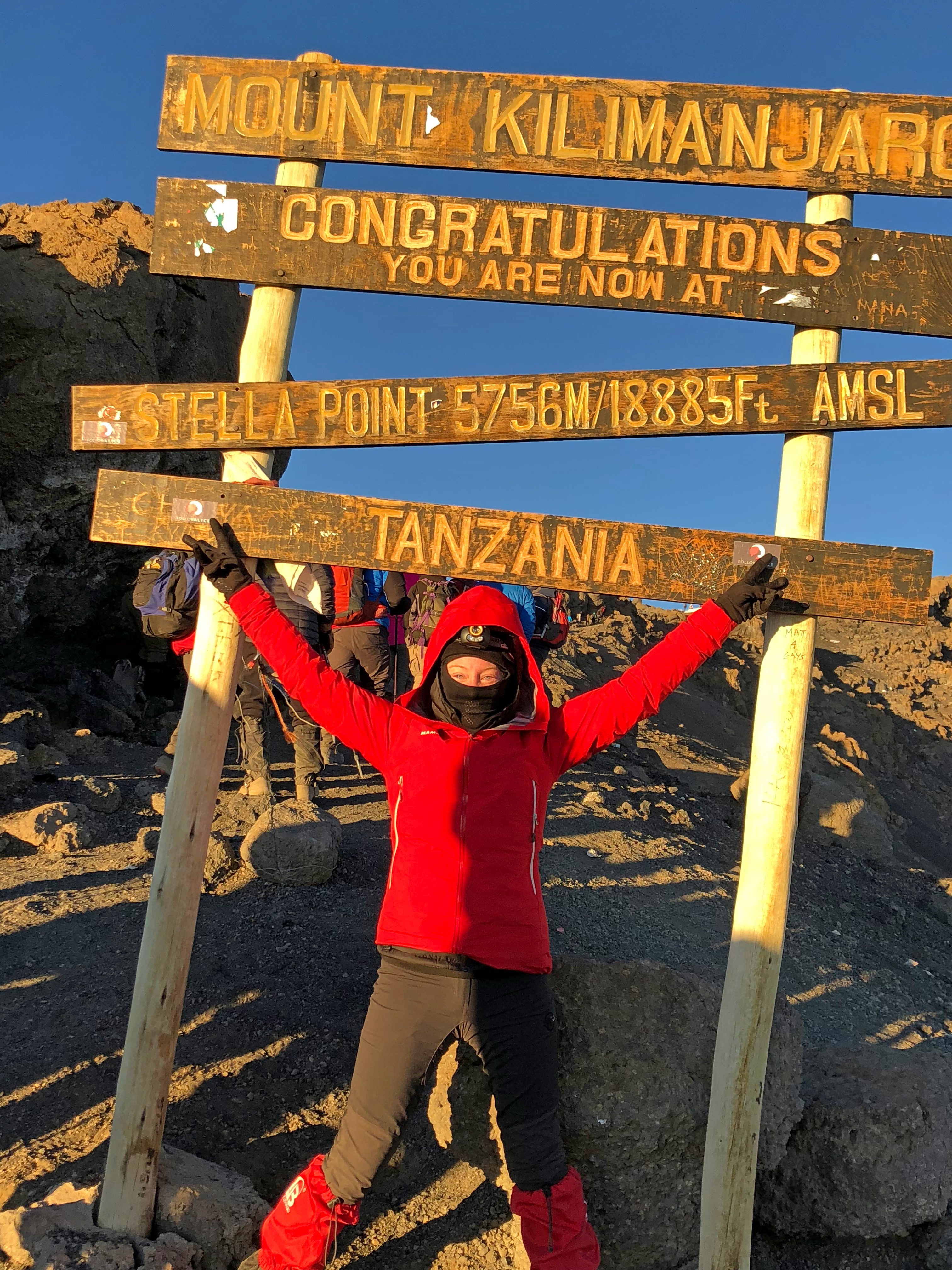
Honestly, the summit sign photo opportunity was anticlimactic and exhausting. The crowd there was extremely pushy and rude. After all that we had been through to get here, it was less of a celebration and more of a selfish attempt for a photo. I waited to get my photo, as I had come all that way to hit the summit and needed proof (because if it’s not on social media, did I really summit?). I enjoyed taking photos and exploring the glaciers way more. There were less crowds, and I wanted to really get a glimpse of the receding glaciers, a sign of rapid climate change. In fact, it is predicted that in our lifetime the glaciers will recede completely. That really made me sad, and I hope to do my best to protect our beautiful planet as much as I can. If not for me, for future generations to come.
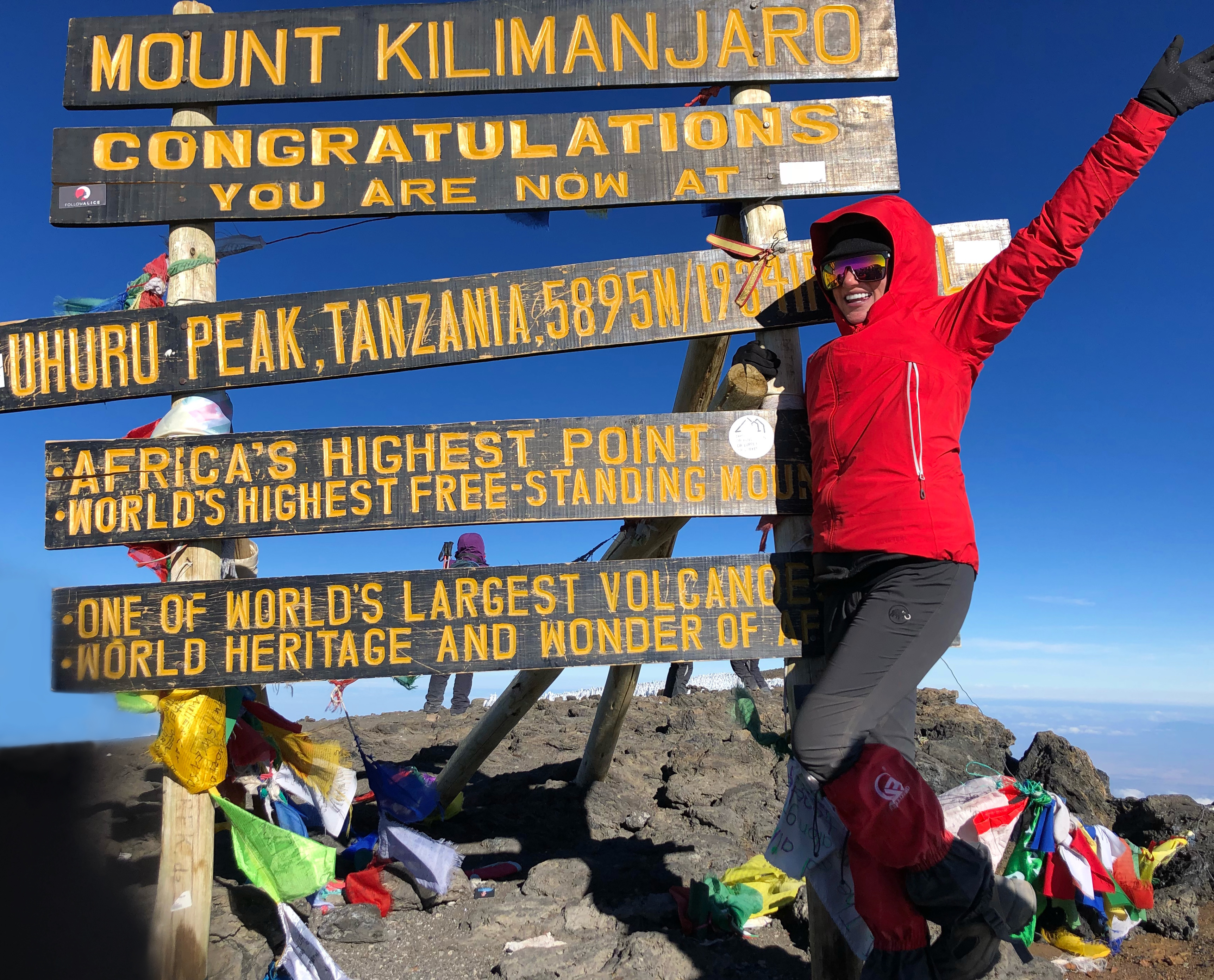
I didn’t want to leave the summit just yet, but the guides said it was time to start our descent. I was feeling really good: happy and in awe of everything as usual. I wanted to stay for a while longer but I knew it was time to go. I had been up there for almost 30 minutes. I took one last look, and started to make my way back to camp.
For the beginning of the descent I was so eager to scree-ski and run down. It was exhilarating, going so fast down the mountain that we had worked so long and tirelessly for. In typical Kirsten form I quickly ate it, and rolled around in the dust. The dust there is fierce, and I decided to just finish the descent to camp by walking quickly with some of the group and simultaneously blowing the crap out of my nose (which takes hours, if not days, to fully get rid of.)
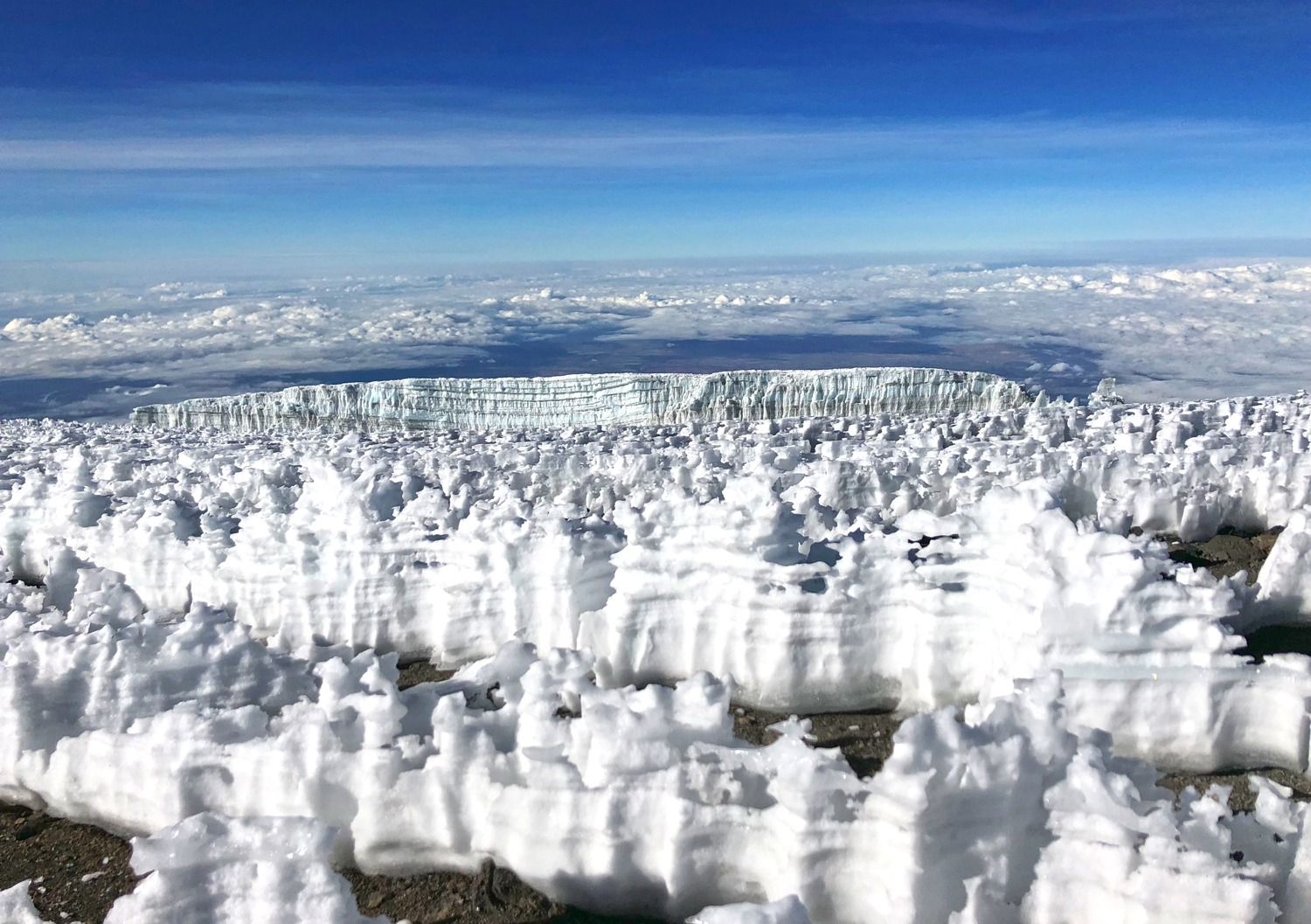
Back at camp we had lunch and took a quick nap before setting off to our final camp. When I woke up it had started to hail (our only “bad weather” of the trip) so we quickly packed and made our way down.
That night it was still hard to take everything that I had just accomplished in. It seemed so surreal, like a dream. I could not believe I had just made the summit, something I was so nervous about months before. I had the best sleep on the mountain that night.
Day Seven: Bon Voyage
I woke up around 6 in the morning to the sounds of birds and monkeys chirping, and got out of the tent to see one last sunrise on the mountain. We were served our last hot breakfast, and then got to personally meet the team of porters that had not only helped carry our gear up the mountain, but food, tents and their own gear as well. Without them this whole trip could not have been possible, and I am forever grateful and humbled by their hard work and dedication.
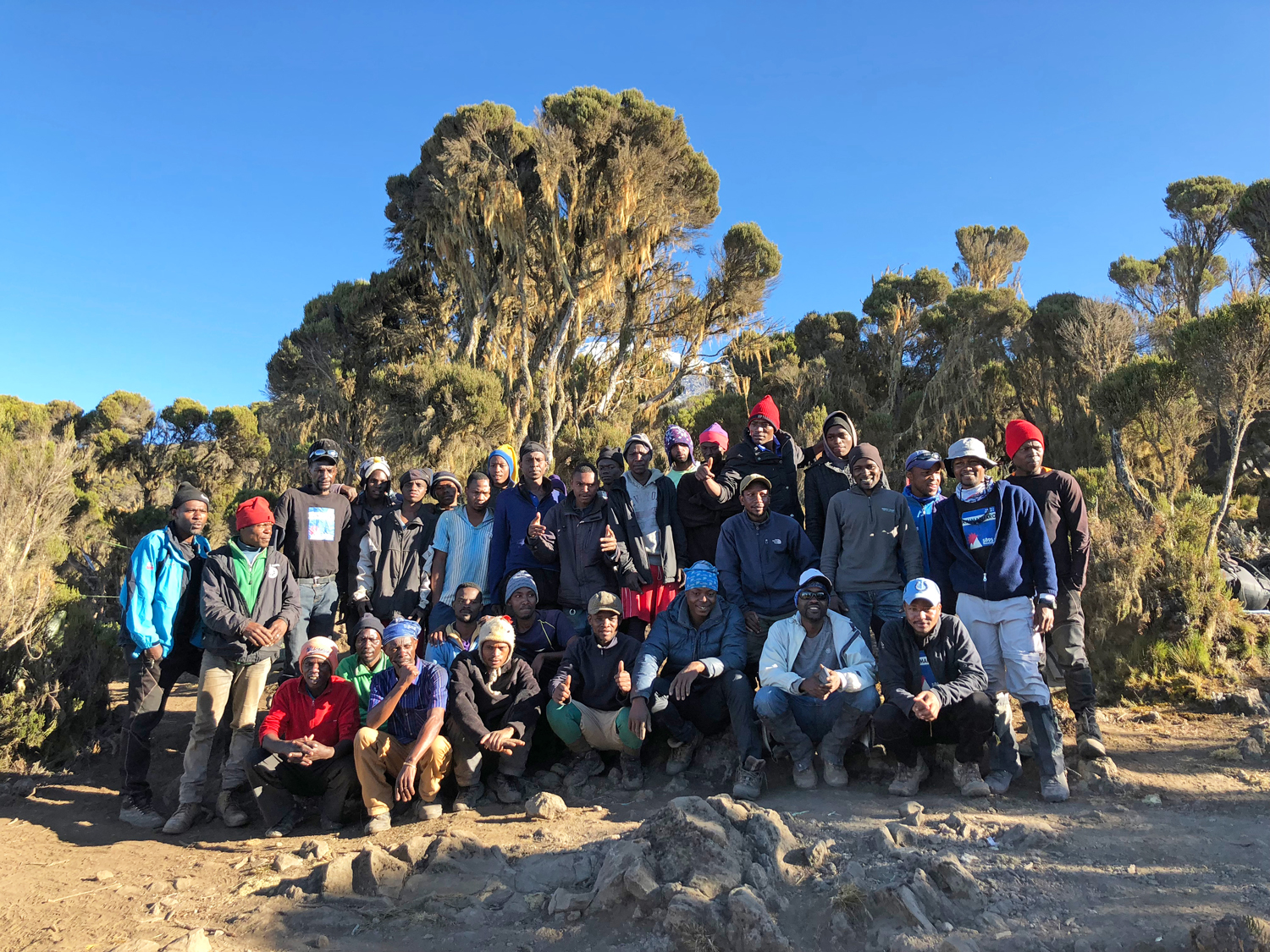
It was a beautiful sunny day, and it was time to make our way back into the rainforest and ultimately the hotel. We descended for a few short hours until we reached the Mweka Gate. We registered our names for one last time, and afterwards I got my shoes cleaned. For five dollars (USD) it was worth every penny! I felt like I had a brand new pair of shoes. After all the years of wear and tear and the layers of dust from this trek, they really needed some love.
I also purchased a few bottles of Coca-Cola. After hiking on the mountain for a week, I was craving something that reminded me of home.
We took the bus to get a well-deserved lunch and then back to Moshi, where we would have hot showers and one last dinner as a group. After the meal we got our certificates of completing the trek and went on our own ways. The next day I woke up early yet again, this time for a two day wildlife safari in Tarangirie National Park and Ngorongoro Crater. It was the perfect way to end my Tanzania trip, and I can say with certainty that I will be back.
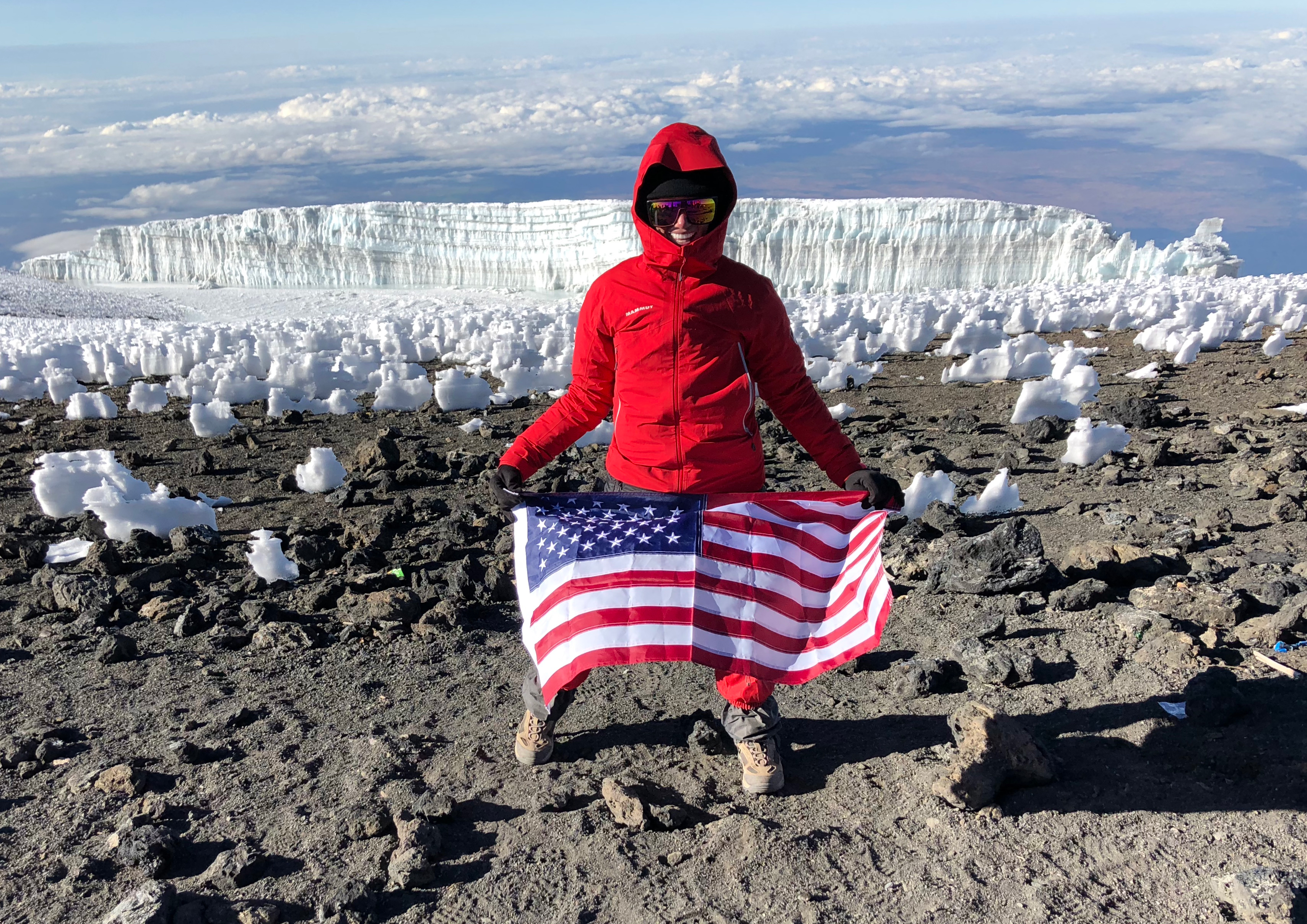
So what did I learn from all of this?
Make each day count on your journey. It’s not just about the summit, but the journey and completion of each day. I like to start each day by setting a goal, and then crushing it! It makes it more enjoyable that way, and then you have little victories to look forward to.
Pole Pole. Slow the hell down. It seems like a pain in the ass at first, but trust me when I say it works. It works so well I seriously felt like I was at sea level a lot of the time. Go slowly. Live in the moment and take everything in.
I am a lot stronger and more powerful than I thought. I was really nervous at first, hearing horror stories of altitude sickness from various climbers and online forums. Trust in yourself and your abilities and you will do well. A lot of mountain trekking is mental too, so go with a positive mindset.
Believe you can, and you will!
Founder and main contributor to This Adventure Life, Kirsten Alexis has passion for all things adventure and the outdoors. She is an avid participant in action sports, such as skydiving, paragliding, snowboarding, high-altitude trekking, mountain biking, surfing and more. She is passionate about inspiring others to live their wildest dreams as well as conserving the environment for others to enjoy for years to come.
